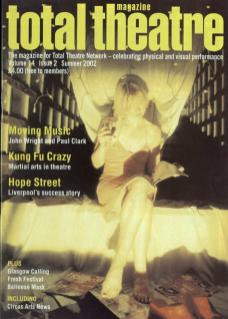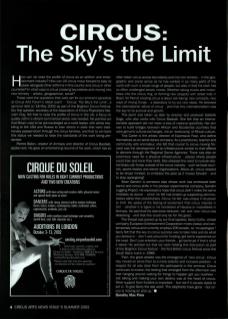How can we raise the profile of circus as an artform and entertainment industry? How can UK circus move forward to take its place alongside other artforms in this country and circus in other countries? In what ways is circus crossing boundaries and moving into new territory – artistic, geographical, social?
These were the questions that were set for our eminent panellists at Circus Arts Forum's latest event – ‘Circus: The Sky's the Limit', a seminar held on 18 May 2002 as part of the Brighton Circus Festival. Our first speaker, secretary of the Association of Circus Proprietors Malcolm Clay, felt that to raise the profile of circus in the UK, a focus on quality within a vibrant commercial sector was needed. He pointed out that Britain used to be acknowledged as a world leader, with artists travelling to the USA and Russia to train others in skills that were traditionally passed down through the circus families, and that to win back this status we needed to raise the standards of the work being presented.
Pierrot Bidon, creator of Archaos and director of Circus Baobab, spoke next. He gave an entertaining resume of his work, which has so often taken circus across boundaries and into new territory – in the geographic and social sense as he has worked in so many parts of the world with such a broad range of people, but also in that his work has so often challenged artistic mores. Whether taking trucks and motorbikes into the circus ring, or forming new projects with street kids in Brazil, for Pierrot creating circus is about risk-taking new concepts, new ways of mixing things – a laboratory to try out new ideas. He stressed the international nature of circus – and that this internationalism was the key to its survival and growth.
This point was taken up later by director and producer Isabelle Sage, who also works with Circus Baobab. She felt that an internationalist approach did not mean a loss of national specificity. Her aim was to build bridges between African and Occidental countries that were genuine cultural exchanges, not an ‘exoticising’ of African culture.
Tina Carter is the artistic director of Expressive Feat, who define themselves as an aerial dance company. As a practitioner, teacher and community arts animateur, she felt that crucial to circus moving forward was the development of an infrastructure similar to that offered to dancers through the Regional Dance Agencies. There was also an enormous need for a physical infrastructure – places where people could train and hone their skills. She stressed the need to nurture relationships with those outside of the circus industry – such as local councils, sports bodies and dance organisations. Above all, circus needed to be broad minded, to embrace the past as it moves forward – and to stop apologising!
Sean Gandini is someone else whose work has embraced both dance and circus skills in his pioneer experimental company, Gandini Juggling Project. He expressed a hope that circus didn't make the same mistakes as dance – which he felt has ended up supporting administrators rather then practitioners. Circus, he felt, was unique in its power to thrill. He spoke of the feeling of excitement that circus inspires in him – whether it is tigers in his homeland of Havana or motorbikes in Archaos. He said that the distinction between 'old' and 'new’ circus was dissolving – and that this could only be for the good.
This thread was picked up by our final speaker, Gerry Cottle, whose company European Entertainment Corporation mixes classic and contemporary circus and currently employs 200 people, so 'no apologies'! Gerry felt that the key to circus success was to take risks and do what you believe in – don't wait around for funding, get some experience on the road. Don't just entertain your friends – go bankrupt if that's what it takes! He pointed out that we were holding this discussion as part of the Brighton Circus festival – the first British circus festival since the South Bank event in 1989.
Then, the great debate was the emergence of new circus. Circus has moved on since then to a more eclectic and inclusive position – a respect for all was clear from the participants in the seminar. Circus continues to evolve; the feeling that emerged from the afternoon was that hanging around waiting for things to happen got you nowhere – risk taking and making your own destiny was at the heart of circus. More support from funders is important – but not if it causes stasis to set in. To give Gerry the last word: ‘The elephants have gone – but circus is moving on and up.’

